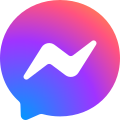A request that this article title be changed to Facebook Messenger is under discussion . Please do not move this article until the discussion is closed. |
 Logo used since 2025 | |||||||||
| Developer(s) | Meta Platforms | ||||||||
|---|---|---|---|---|---|---|---|---|---|
| Initial release | August 9, 2011 April 2020 | ||||||||
| Stable release(s) [±] | |||||||||
| |||||||||
| Preview release(s) [±] | |||||||||
| |||||||||
| Operating system | Web,Android,iOS,Windows 10,Windows 11,Windows Phone,macOS,WatchOS,Wear OS | ||||||||
| Size | 53.33 MB (Android) [6] 124.1 MB (iOS) [7] 169.4 MB (Windows 10 and Windows 11) [8] 91.3 MB (macOS) [9] | ||||||||
| Available in | 111 [10] languages | ||||||||
List of languages Afrikaans, Albanian, Amharic, Arabic, Armenian, Assamese, Azerbaijani, Basque, Belarusian, Bengali, Bosnian, Breton, Bulgarian, Burmese, Catalan, Cebuano, Corsican, Croatian, Czech, Danish, Dutch, Dutch (België), English (UK), English (US), English (upside down), Esperanto, Estonian, Faroese, Filipino, Finnish, French (Canada), French (France), Frisian, Fula, Galician, Georgian, German, Greek, Guarani, Gujarati, Haitian Creole, Hausa, Hebrew, Hindi, Hungarian, Icelandic, Indonesian, Irish, Italian, Japanese, Japanese (Kansai), Javanese, Kannada, Kazakh, Khmer, Kinyarwanda, Korean, Kurdish (Kurmanji), Kyrgyz, Lao, Latvian, Lithuanian, Macedonian, Malagasy, Malay, Malayalam, Maltese, Marathi, Mongolian, Nepali, Norwegian (bokmal), Norwegian (nynorsk), Oriya, Pashto, Persian, Polish, Portuguese (Brazil), Portuguese (Portugal), Punjabi, Romanian, Russian, Sardinian, Serbian, Shona, Silesian, Simplified Chinese (China), Sinhala, Slovak, Slovenian, Somali, Sorani Kurdish, Spanish, Spanish (Spain), Swahili, Swedish, Syriac, Tajik, Tamazight, Tamil, Tatar, Telugu, Thai, Traditional Chinese (Hong Kong), Traditional Chinese (Taiwan), Turkish, Ukrainian, Urdu, Uzbek, Vietnamese, Welsh and Zaza | |||||||||
| Type | Instant messaging, VoIP | ||||||||
| License | Freeware, proprietary | ||||||||
| Website | messenger.com facebook.com/messenger/ | ||||||||
| This article is part of a series about |
| Meta Platforms |
|---|
 |
| Products and services |
| People |
| Business |
Messenger, [11] formerly known as Facebook Messenger, is an American proprietary instant messaging service developed by Meta Platforms. Originally developed as Facebook Chat in 2008, the client application of Messenger is currently available on iOS and Android mobile platforms, Windows and macOS desktop platforms, through the Messenger.com web application, and on the standalone Facebook Portal hardware.
Contents
- History
- Features
- Messenger Rooms
- Monetization
- Reception
- User growth
- Government attempt at surveillance/decryption
- See also
- References
- External links
Messenger is used to send messages and exchange photos, videos, stickers, audio, and files, and also react to other users' messages and interact with bots. The service also supports voice and video calling. The standalone apps support using multiple accounts, conversations with end-to-end encryption, and playing games.




